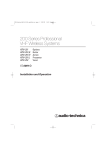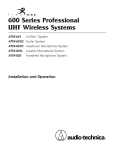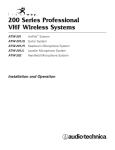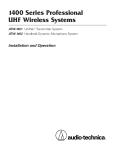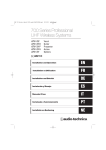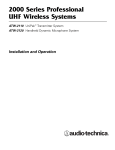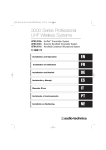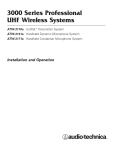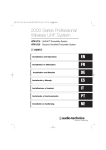Download Audio Technica ATW-1662 Specifications
Transcript
1600 Series Professional UHF Wireless Systems ATW-1661 UniPak™ Transmitter System ATW-1662 Handheld Dynamic Microphone System ATW-1663 Handheld Condenser Microphone System Installation and Operation Professional UHF Wireless Systems Installation and Operation This device complies with EN300 422-1, EN301 489-09 (EMC) and EN60065. The ATW-R160, ATW-T161, ATW-T162 and ATW-T163 are intended to be used in all countries of the European Union. Please note : Frequency usage is different for each country. Your AudioTechnica agent will have all the necessary details on the available legal frequencies for your area. CAUTION! Electrical shock can result from removal of the receiver cover. Refer servicing to qualified service personnel. No user-serviceable parts inside. Do not expose to rain or moisture. The circuits inside the receiver and transmitter have been precisely adjusted for optimum performance and compliance with european regulations (R & TTE directive). Do not attempt to open the receiver or transmitter. To do so will void the warranty, and may cause improper operation. Notice to individuals with implanted cardiac pacemakers or AICD devices: Any source of RF (radio frequency) energy may interfere with normal functioning of the implanted device. All wireless microphones have low-power transmitters (less than 0.05 watts output) which are unlikely to cause difficulty, especially if they are at least a few inches away. However, since a “body-pack” mic transmitter typically is placed against the body, we suggest attaching it at the belt, rather than in a shirt pocket where it may be immediately adjacent to the medical device. Note also that any medical-device disruption will cease when the RF transmitting source is turned off. Please contact your physician or medical-device provider if you have any questions, or experience any problems with the use of this or any other RF equipment. Introduction Thank you for choosing an Audio-Technica professional wireless system. You have joined thousands of other satisfied customers who have chosen our products because of their quality, performance and reliability. This Audio-Technica wireless microphone system is the successful result of years of design and manufacturing experience. Each 1600 Series wireless system provides a choice of PLL-synthesized UHF frequencies. Each wireless system includes a receiver and either a body-pack or handheld transmitter. Individual components are also available separately. 2 The ATW-R160 receiver features true diversity reception. Two antennas feed two completely independent RF sections on the same frequency; automatic logic circuitry continuously compares and selects the superior received signal, providing better sound quality and reducing the possibility of interference and dropouts. Soft-touch controls provide convenient access to a variety of functions, while an LCD information display provides constant monitoring of system operation. The receiver is half-width for a standard 1U 19" rack mount; rack-mount adapters are included. Two receivers can be mounted side by side, using an optional AT8616 joining-plate kit. The versatile ATW-T161 UniPak™ body-pack transmitter has both low- and high-impedance inputs plus a bias connection, for use with dynamic and electret condenser microphones, as well as Hi-Z instrument pickups. The ATW-T162 handheld dynamic microphone/transmitter features a hyper cardioid element created for professional livesound venues. The ATW-T163 handheld condenser microphone/transmitter features a cardioid element created for professional live-sound venues and installations, such as use with inductive loop systems. Transmitters in the 1600 Series use two 1.5V AA batteries for economical operation and wide availability. Tone squelch system in the ATW-R160 receiver opens only when a 1600 Series transmitter is detected, reducing the possibility of interference. As a result, 1600 Series transmitters and receivers must be used together and should not be used with components from other Audio-Technica wireless systems, or with those of other manufacturers. Please note that in multiple-system applications there must be a transmitter-receiver combination set to a separate frequency for each input desired (only one transmitter for each receiver). Due to the wireless frequencies being within UHF TV frequency bands, only certain operating frequencies may be useable in a particular geographic area. Please contact your National Radio Licensing Authority for further information. UK Users: JFMG Limited 33-34 Alfred Place, London WC1E 7PD TEL: 020 7299 8660 FAX: 020 7299 8661 e-mail: [email protected] Receiver Installation Location For best operation the receiver should be at least 1 m above the ground and at least 1 m away from a wall or metal surface to minimise reflections. The transmitter should be at least 1 m from the receiver, as shown in Figure A. Keep antennas away from noise sources such as digital equipment, motors, automobiles and neon lights, as well as large metal objects. Output Connections There are two audio outputs on the back panel: balanced (32 mV) and unbalanced (52 mV). Use shielded audio cable for the connection between the receiver and the mixer. If the input of the mixer is a 1/4" jack, connect a cable from the 1/4" unbalanced audio output on the back of the receiver housing to the mixer. If the input of the mixer is an XLR-type input, connect a cable from the balanced XLR-type audio output on the back panel to the mixer. The two isolated audio outputs permit simultaneous feeds to both unbalanced and balanced inputs. For example, both a guitar amp and a mixer can be driven by the receiver. Antennas Attach the included pair of UHF antennas to the antenna input jacks. The antennas are normally positioned in the shape of a “V” (both 45° from vertical) for best reception. Antennas can be remotely located from the receiver. However, due to signal loss in cables at UHF frequencies, use the lowest-loss RF cables practical for any cable runs over 25 feet (8 m ). RG8-type is a good choice. Use only copper-shielded cable, not CATV-type foil-shielded wire. Audio-Technica offers quality RF cables in four lengths, as well as remote antennas; see the Optional System Accessories section on page 9. Power Connections Connect the supplied AT 220 ~ 240V, 50Hz AC adapter to the DC power input on the back of the receiver. Operation of the receiver is controlled by the front-panel Power switch. Figure A 3 Receiver Controls and Functions Front Panel Controls and Functions (Figure. B) 1. POWER SWITCH/INDICATOR: Press switch on, and the "Power" indicator will light. 2. LCD WINDOW: Liquid Crystal Display indicates control settings and operational readings. See Figure D for examples. 3. TUNER OPERATION INDICATOR: Indicates which Tuner (A or B) has the better reception and is in operation. 4. SET BUTTON: Activates access to Frequency/Scan mode and sets or cancels selected function when used in combination with CH SELECT/SCAN button (Item 5).5. 5. CH SELECT/SCAN BUTTON: Use in conjunction with the SET button (Item 4) to select operation frequency and scan function. 6. AF LEVEL CONTROL: Adjusts audio output level of both AF Output jacks; maximum output is fully clockwise. 7. SQUELCH CONTROL: Adjusts level of noise-muting circuit (preset at factory but can be adjusted as circumstances warrant). 8. MOUNTING ADAPTERS: For mounting the receiver in any standard 19" rack. Attach adapters to the receiver with the screws supplied and remove the four receiver feet. (Use optional AT8616 joining-plate kit to mount two ATW-R160 receivers side-by-side.) 9. PLL Lock indicator: This indicates Phased Lock Loop frequency controlled oscillator has locked displayed frequency. Figure B 8 3 2 9 4 5 7 6 8 1 Rear Panel Controls and Functions (Figure C) 10. ANTENNA INPUT JACK: BNC-type antenna connector for Tuner “B.” Attach the antenna directly, or extend it with a low-loss antenna cable. See the “Antennas” section on page 3 for more details. 11. ANTENNA INPUT JACK: Input for Tuner “A.” Attach the antenna directly, or extend it with a low-loss antenna cable. 12. GROUND LIFT SWITCH: Disconnects the ground pin of the balanced output jack (12) from ground. Normally, the switch should be to the left (ground connected). If hum caused by a ground loop occurs, slide switch to the right (ground lifted). 13. BALANCED AUDIO OUTPUT JACK: XLRM-type connector. A standard 2-conductor shielded cable can be used to connect the receiver output to a balanced microphone-level input on a mixer or integrated amplifier. 14. UNBALANCED AUDIO OUTPUT JACK: 1/4" phone jack. Can be connected to an unbalanced aux-level input of a mixer, guitar amp or tape recorder. 15. POWER INPUT JACK: Connect the DC plug from the included AC adapter. 16. ATW-RA1 Rack-Mount Antenna kit mounting Holes: Mount optional front-mount antenna kit ATW-RA1 on these holes. Figure c 16 16 Power On/Off To turn the receiver on, press the Power switch. The Power light and the LCD window will come on after about 1-2 seconds. The operating channel number and frequency will be displayed in the window after the power-up sequence. To turn the receiver off, press the Power switch again. How to Make Setting Changes A. Select Frequency Manually 1. From the normal operating mode, press and hold the set button until display flashes. 2. To select frequency, press CH SELECT/SCAN button once at a time until desired channel is displayed (1 to 9, A to F). 3. (a) To select frequency, press and hold SET button until display stops flashing. (b) To cancel frequency selection, simply press the SET button once. The receiver then returns to the normal operation. 4 16 10 13 12 14 15 11 16 B. Select Open Frequency Scan Function 1. From the normal operating mode, press and hold the set button until display flashes. 2. To select scan function, press and hold CH SELECT/SCAN button, continue to hold until available frequency is automatically displayed. 3. (a) To select frequency, press and hold SET button until display stops flashing. (b) To cancel frequency selection, simply press the SET button once. The receiver then returns to the normal operation without making any changes. Figure D ANT A ANT B AF RF CHANNEL 840.125 MHZ Transmitter Setup Battery Selection and Installation Each transmitter uses two 1.5V AA batteries, not included. Alkaline type is recommended. Always replace both batteries. Make certain the transmitter power is Off before replacing batteries. UniPak™ Transmitter Battery Installation 1. Slide off the battery cover as shown in Figure E. 2. Observe correct polarity as marked inside the battery compartment, and carefully insert two fresh 1.5V AA alkaline batteries. 3. Replace the Battery cover (Figure.E) Figure E Microphone Guitar Trimmer (GT) Trimmer (MT) Battery Condition Indicator The Green Battery condition indicator(Figure I/ J) should light strongly with a fresh battery. As the battery weakens, the indicator will glow Red. When the Indicator becomes Red, there is little life left in the battery. Replace it at once for continued operation of the transmitter. Battery Save Switch ATW-T161 Transmitter features RF Lo / Hi Power switch (Figure E). As supplied, the switch is set in the Lo (Low) position for the maximum battery life. Hi(High) position can be selected for maximum range (Note range decreases when the switch is set at Lo position.) Special Note: If accessing de-regulated frequencies between 863 to 865MHz(Ch. C to F), ATW-T161 must be set to RF Low. Figure I Power Switch OFF / ON Figure J Battery Condition Indicator Power Switch ON / OFF Channel Selector Battery-Save Switch Battery Polarity (under screwdriver clip) Diagram Input Connector Figure F Antenna Battery Condition Indicator UniPak Transmitter Input Connection Handheld Transmitter Battery Installation 1. While holding the upper part of the transmitter body just below the ball-screen, unscrew the lower body cover and slide downward to remove and expose battery compartment. 2. Be certain to observe correct polarity as marked inside the battery compartment (Figure G) and carefully insert two fresh 1.5V AA alkaline batteries. Make certain the batteries are fully seated in the battery compartment. 3. Replace the lower body cover. Do not overtighten. Figure G Connect an audio input device (microphone or guitar cable) to the audio input connector on the bottom of the transmitter. A number of Audio-Technica professional microphones and cables are available separately, pre-terminated with a UniPak input connector (see “Optional System Accessories” on page 9). Transmitting Antenna The UniPak transmitter includes a permanently-attached flexible antenna. For best results, allow the antenna to hang freely and full length from the bottom of the transmitter. If the received signal is marginal, experiment with different transmitter positions on your body or instrument; or try repositioning the receiver. Do not attempt to remove, replace or change the length of the transmitting antenna. The antenna for the ATW-T162 and ATW-T163 handheld transmitters are located at the bottom of the units. For the best results, hold the Microphone naturally around the centre of the body. Holding or otherwise covering antenna housing may affect operating range. Battery Polarity Diagram Figure H Channel Selector Gain Trimmer Screwdriver 5 System Operation Switch on the receiver. Do not switch on the transmitter yet. Receiver Squelch Selecting/Setting Frequency It’s usually best to start by setting the receiver’s frequency to determine there is no local interference on that frequency. Then, always make certain to set the transmitter to the receiver’s exact frequency. The receiver’s Tone Lock system squelches the audio only, permitting any RF energy on the frequency to show on the “RF” bar-meter. The 1600 Series employs a Tone Lock squelch system that provides enhanced rejection of RF interference. The squelch control on the front panel of the receiver is preset at the factory, but can be adjusted if you are using the system in a high RF interference area. This adjustment can cause a reduction in the useable range of the wireless transmitter, so set the control to the lowest position which reliably mutes the unwanted RF signals. Receiver On… The Power switch indicator and the LCD window will light up, the normal-operation LCD display will appear after 1-2 seconds (Figure D). If any of the bars show in the “RF” bar-graph meter, there may be RF interference in the area. If this occurs, select another frequency as explained below. Input Level Adjustment An input trimmer control (Trim) in the transmitters enables you to maximize performance for a particular microphone or guitar sensitivity, or to adjust for different acoustic input levels. How to Make Setting Changes A. Select Frequency Manually 1. From the normal operating mode, press and hold the set button until display flashes. 2. To select frequency, press CH SELECT/SCAN button once at a time until desired channel is displayed (1 to 9, A to F). 3. (a) To select frequency, press and hold SET button until display stops flashing. (b) To cancel frequency selection, simply press the SET button once. The receiver then returns to the normal operation. B. Select Open Frequency Scan Function 1. From the normal operating mode, press and hold the set button until display flashes. 2. To select scan function, press and hold CH SELECT/SCAN button, continue to hold until available frequency is automatically displayed. 3. (a) To select frequency, press and hold SET button until display stops flashing. (b) To cancel frequency selection, simply press the SET button once. The receiver then returns to the normal operation without making any changes. Setting Transmitter Frequency ATW-T161 Slide the Battery cover off and use screwdriver provided to set the channel switch to the same channel selected on the receiver. ATW-T162, ATW-T163 While holding the upper part of the transmitter body just below the ball-screen, unscrew lower body cover, slide downward and remove to expose battery compartment. Use screwdriver provided to set the channel switch to the same channel selected on the receiver. 6 CAUTION! The small trimmer controls are delicate; use only the supplied screwdriver. Do not force the trimmers beyond their normal 190 o range of rotation. Return the screwdriver to its storage clip when not in use. Setting Levels Correct adjustment of transmitter audio input, receiver audio output, and mixer/amplifier input and output levels is important for optimum system performance. Adjusting Input Level - UniPak Transmitter Slide the battery cover off the top part of transmitter and remove the screwdriver from its clip (Figure E). Gently turn the "MT" (mic trimmer) and "GT" (guitar trimmer) control to their full counterclockwise positions (marked “Lo”). • Microphone: Adjusting input level While speaking /singing into the microphone at typically-loud levels, carefully turn the MT control clockwise while watching the receiver’s AF Level indicator. Increase the Trim control setting until the maximum audio output of the mic lights about three or four units on the receiver's AF Level indicator. Do not set the level too high. At normal audio levels, only the first two or perhaps three units should light. (When using a microphone, return the GT control setting to minimum) • Guitar/Instrument: Adjusting input level While playing at typically-loud levels, carefully turn the GT control clockwise while watching the receiver’s AF Peak indicator. Increase the Trim control setting until the maximum audio output of the mic lights about three or four units on the receiver's AF Level indicator. Do not set the level too high. After adjusting input level, return the screwdriver to its clip and reinstall the battery cover. No further transmitter gain adjustments should be needed, as long as the input device and the acoustic input level are not changed. System Operation Adjusting Input Level - Handheld Transmitter Unscrew the lower body cover and slide it downward, exposing the screwdriver and Trim control (Figure G and H). Remove the screwdriver and gently turn the Trim control marked "VR" (variable resistor) to its full counterclockwise position. While speaking /singing into the microphone at typically loud levels, carefully turn the VR control clockwise while watching the receiver’s AF Level indicator. Increase the VR control setting until the maximum audio output of the mic lights three or four units on the receiver's AF Level indicator. Do not set the level too high. At normal audio levels, only the first two or three units should light. (Continued) RF Interference Please note that wireless frequencies are shared with other radio services. According to the National Communication Authority, “Wireless microphone operations are unprotected from interference from other licensed operations in the band. If any interference is received by any Government or nonGovernment operation, the wireless microphone must cease operation...” If you need assistance with operation or frequency selection, please contact your dealer. Extensive wireless information is also available on the Audio-Technica US Web site at www.audio-technica.com Return the screwdriver to its clip and close and secure the lower body. No further transmitter gain adjustments should be needed, as long as the acoustic input does not change significantly. RF Power Adjustment ATW-T161 RF power may be set to RF "Hi” (20 mW nominal) or RF "Lo” (10 mW nominal) via battery save switch (Figure E). The default setting is RF "Lo”. While the RF "Hi” setting normally provides maximum operating range, the RF "Lo” setting will help extend battery life. The RF "Lo” setting may also be preferred in multi-channel systems, or when operating very close to the receiver, to reduce the possibility of interference or overload. Special Note: If accessing de-regulated frequencies between 863 to 865MHz(Ch. C to F), ATW-T161 must be set to RF Low. Ten Tips to Obtain the Best Results 1. Use only fresh alkaline batteries. Do not use “general purpose” (carbon-zinc) batteries. 6. The receiver and transmitter must be set to the same frequency. 2. Position the receiver so that it has the fewest possible obstructions between it and the normal location of the transmitter. Line-of-sight is best. 7. A receiver cannot receive signals from two transmitters at the same time. 3. The transmitter and the receiver should be as close together as conveniently possible, but no closer than three feet (1 m). 4. Avoid placing the receiver in a low or shielded location where the transmitter and receiver antennas are not visible to each other. If necessary, use remotely-located receiver antennas. 5. Avoid placing the receiver near computers or other RF generating equipment. 8. Do not obstruct the handheld transmitter’s antenna (located at the base) or attached body-pack transmitter’s antenna with your hands. 9. You need to change frequencies 1) when a strong interference signal is received, 2) when audio quality is poor due to weak RF, or 3) during multiple-system operation in order to select an interference-free frequency. 10. Turn the transmitter off when not in use. Remove the batteries if the transmitter is not to be used for a period of time. 7 Specifications† OVERALL SYSTEM UHF Operating Frequency * Number of Channels Frequency Stability Modulation Mode Normal Deviation Operating Range Operating Temperature Range Frequency Response ATW-R160 RECEIVER Receiving System Image Rejection Signal-to-noise Ratio Total Harmonic Distortion Sensitivity Intermediate Frequency Audio Output Unbalanced: Balanced: Output Connectors Unbalanced: Balanced: Power Supply Dimensions Weight Accessories Included EX: 795.500 to 819.025 MHz UK: 840.125 to 864.375 MHz 16 ±0.005%, Phase Lock Loop frequency control FM ±10 kHz 100 m typical 41° F (5° C) to 113° F (45° C) 70 Hz to 15 kHz Dual independent receivers, automaticswitching diversity 55 dB nominal 105 dB at 22.5 kHz deviation (IEC-weighted), maximum modulation 36 kHz ≤1% (10 kHz deviation at 1 kHz) 15 dBµV (S/N 60 dB at 22.5 kHz deviation, IEC-weighted) 65.75 MHz, 10 MHz 52 mV (at 1 kHz, ±5 kHz deviation, 10k ohm load) 32 mV (at 1 kHz, ±5 kHz deviation, 10k ohm load) 1 /4" TS (“mono”) phone jack XLRM-type 12-18V DC, 500 mA external supply, center positive. 210.0 mm)W x 49.0 mm H x 195.0 mm D 2.4 lbs (1.1 kg) Two flexible UHF antennas; rack-mount adapters ATW-T161 UNIPAK™ TRANSMITTER RF Power Output ** According to National Regulations Spurious Emissions ETS 300 422-2 Dynamic Range ≥110 dB, A-weighted Input Connections High impedance, low impedance, bias Batteries (not included) Two 1.5V AA alkaline Current Consumption 160 mA, typical Battery Life Approximately 6 hours (High); 8 hours (Low), depending on battery type and use pattern Dimensions 65.0 mm W x 87.0 mm H x 24.0 mm D Net Weight (without batteries) 90 grams ATW-T162, ATW-T163 HANDHELD TRANSMITTER RF Power Output** According to National Regulations Spurious Emissions ETS 300 422-2 Dynamic Range ≥110 dB, A-weighted Microphone Element ATW-T162: Dynamic Hyper-cardioid (unidirectional) ATW-T163: Condenser Cardioid (unidirectional) Batteries (not included) Two 1.5V AA alkaline Current Consumption 170 mA, typical Battery Life Approximately 8 hours, depending on battery type and use pattern Dimensions 240.0 mm long, 48.0 mm diameter Net Weight (without batteries) 240 grams Accessory Included AT8456a stand clamp † * ** Carrier frequency, maximum deviation and output power depends on government regulations. Complies to the R & TTE Directive Specifications are subject to change without notice. 0700 8 Optional System Accessories WIRELESS ESSENTIALS™ MICROPHONES AND CABLES All Wireless Essentials accessories are terminated for use with ATW-T1600 and other UniPak™ transmitters. AT829cW Miniature cardioid condenser lavalier microphone. Includes clothing clip and windscreen. MT830cW Subminiature omnidirectional condenser lavalier microphone. Includes clothing clip and windscreen. MT830cW-TH “Theatre” model, same as MT830cW except beige colour mic and cable for concealment. AT831cW Miniature cardioid condenser lavalier microphone. Includes clothing clip and windscreen. AT851cW Surface-mount wide-range semi-cardioid condenser microphone. AT857AMLcW 19" gooseneck cardioid microphone. Mounts to 5/8"-27 thread. Includes windscreen. AT889cW Headworn noise-cancelling condenser microphone. Includes windscreen and cable clip. ATM35cW Cardioid condenser instrument microphone. Includes AT8418 clip-on instrument mount. ATM73cW Headworn cardioid condenser microphone. Includes windscreen. ATM75cW Headworn cardioid condenser microphone. Includes windscreen. PRO 8HEcW Headworn hypercardioid dynamic microphone. Includes windscreen and cable clip. PRO 35xcW Cardioid condenser instrument microphone. Includes AT8418 clip-on instrument mount. AT8319 Hi-Z instrument/guitar cable with 1/4" phone plug. AT8317 Connecting cable for UniPak transmitter with an XLRF-type input connector, for Lo-Z microphones with XLRM-type output terminations. RECEIVER ACCESSORIES AT8616 Joining-plate kit allows rack-mounting two ATW-R160 receivers side-by-side in a single (1U) 19" rack space. ATW-A20 Pair of UHF ground-plane antennas with 5/8"-27 thread for mounting to microphone stands, etc. For use with ATW-R160 receivers. Takes RF cables with BNC connectors, not included; see RF Cables below. ATW-A49 Pair of UHF wide-band directional LPDA (log periodic dipole array) antennas provide enhanced signal pickup for UHF wireless systems throughout a wide band range (440-900 MHz). Each antenna paddle is matched to 50 ohms impedance with and integral hi-quality low -loss BNC connector, 6dB gain. For permanent or temporary installation; mounts to 5/8"-27 threads. AEW-DA800EU UHF ( DA800: 795-820, DA860: 840-865 MHz) active AEW-DA860UK unity-gain antenna distribution system provides two “1-in, 4-out” RF channels; connects a pair of antennas to as many as four diversity receivers. A cascade ouput is provided as a directional coupler to drive additional distribution amps. Includes four DC interconnect cables to power up to four receivers, eight RF output cables and two rack-mount adapters. Mounts in a single (1U) 19" rack space. For use with ATW-R160 EX (ATW-DA800) and ATW-R160 UK (AEW-DA860) receivers. ATW-RA1 Rack-mount antenna kit brings antenna inputs to the front of receiver for ease of setup, or when receiver is enclosed in a metal rack. Includes a pair of extendable antennas. NOTE: Two adapter kits are required when mounting two receivers side-by-side in a single 19" rack space. RF Cables Low-loss design, 50 ohm impedance, with BNC-to-BNC connectors: AC12 RG58-type cable (12') AC25 RG8-type cable (25') AC50 RG8-type cable (50') AC100 RG8-type cable (100') TRANSMITTER ACCESSORIES AT8114 Foam windscreen for handheld transmitter. AT8141 Water-resistant pouch for UniPak transmitter. AT8390 Shielded audio cable with 1/4" to 1/4" phone plugs. Available in a variety of lengths. (Also available with one straight and one 90° phone plug as the AT8316.) AT8456a Stand clamp for handheld transmitter, 5/8"-27 threads. 9 Troubleshooting Guide Receiver is not on (LCD window does not light). • Receiver Power switch is not pressed in. • Small DC power cord from included in-line power supply is not plugged into jack on back of receiver. • The power supply is not plugged into AC power outlet. • AC power is not present at the AC outlet. Receiver is on (LCD window lights) • No sound: ✓“RF” and "AF" level meters both show good signals. • AF Level control on front of receiver not turned up (clockwise). [See p. 4.] Note: If the “AF” level meter shows a good signal on the receiver when the transmitter is receiving audio input, and the AF Level control is turned up, then the problem is in connections to, or control settings on the mixer, amplifier, etc. ✓Only “RF” level meter shows good signal; no “AF” signal. • No sound input to mic. • ATW-T161 body-pack only: Wrong input trim selected (“GT”or “MIC”). [See p. 5.] Receiver is on (LCD window lights) • No sound: ✓“RF” and “AF” level meters both show good signals. • The transmitter audio level is too high [See p. 4 & 5] ✓Neither the “RF” nor the “AF” level meter shows any signal. • Receiver antennas not connected. • Transmitter is turned off. • Transmitter is set to a different frequency. • Transmitter batteries are dead or missing. Receiver is on (LCD window lights) • Distorted sound: ✓“RF” and/or “AF” level meters may show good signals. • The transmitter audio level is too high. [See p. 6 & 7.] • Received RF level may be too low (only one or two bars). • Batteries may be weak; check “BATT” condition indicator. [See p. 5] 10 Momentary loss of sound/noisy sound as transmitter is moved around performing area. • Transmitter and receiver antennas not in line-of-sight (or perhaps too far apart). Adjust positions of units so they are visible to each other/closer together. If problem persists. use remote antennas located closer to the transmitter location. • Signal blockage or interference from large metal objects, other wireless units located too close and/or on incompatible frequencies, computer or lighting equipment. • Squelch setting may be set “tighter” than it needs to be. [See p. 6] With transmitter on, received signal is noisy or contains extraneous sounds. • Batteries may be weak. Check “Battery condition indicator and “RF” meter level. • Local TV transmissions on this frequency. • Nearby sources of RF interference, such as computers, lighting equipment, etc. • Two transmitters may be operating on the same frequency. Locate and turn one off or change its frequency. • In multiple-system use, two (or more) incompatible frequencies may have been selected. Refer to the suggested multi-channel frequency combinations. on supplement sheet, ATW-1600 SERIES PROFESSIONAL UHF WIRELESS SYSTEM FOR USE IN THE UK Cannel No. Band 0 Co-ordinate 1 2 3 4 5 6 Shared 7 8 9 A B C De-regulated D E F Frequency (MHZ) 840.125 840.375 841.125 841.375 844.250 845.500 854.900 855.275 856.575 857.625 860.900 861.200 863.125 863.375 864.125 864.375 Group 1 O O O O O O O O 2 O O O O O O O O O Notes: Frequencies listed in Group 1 should be used for Open Frequency Scan Function. Please note that Band UK antenna colour code is grey 11 ATW-1600 SERIES PROFESSIONAL UHF WIRELESS SYSTEM STATEMENT OF COMPLIANCE FOR USE IN THE UK Usage :The ATW-T161 and ATW-T162 are intended to be used in all countries of the European Union. Please note : Frequency usage is different for each country. Your Audio-Technica agent will have all the necessary details on the available legal frequencies for your area. Statement of Compliance :Audio-Technica hereby declares that the ATW-T161 and ATW-T162 are in compliance with the essential requirements and other relevant provisions of Directive 1999/5/EC. Audio-Technica vakuuttaa täten että ATW-T161, ATW-T162 tyyppinen laite on direktiivin 1999/5/EY oleellisten vaatimusten ja sitä koskevien direktiivin muiden ehtojen mukainen. Hierbij verklaart Audio-Technica dat het toestel ATW-T161, ATW-T162 in overeenstemming is met de essentiële eisen en de andere relevante bepalingen van richtlijn 1999/5/EG Bij deze verklaart Audio-Technica dat deze ATW-T161, ATW-T162 voldoet aan de essentiële eisen en aan de overige relevante bepalingen van Richtlijn 1999/5/EC. Par la présente Audio-Technica déclare que l'appareil ATW-T161, ATW-T162 est conforme aux exigences essentielles et aux autres dispositions pertinentes de la directive 1999/5/CE Par la présente, Audio-Technica déclare que ce ATW-T161, ATW-T162 est conforme aux exigences essentielles et aux autres dispositions de la directive 1999/5/CE qui lui sont applicables Härmed intygar Audio-Technica att denna ATW-T161, ATW-T162 står I överensstämmelse med de väsentliga egenskapskrav och övriga relevanta bestämmelser som framgår av direktiv 1999/5/EG. Undertegnede Audio-Technica erklærer herved, at følgende udstyr ATW-T161, ATW-T162 overholder de væsentlige krav og øvrige relevante krav i direktiv 1999/5/EF Hiermit erklärt Audio-Technica, dass sich dieser/diese/dieses ATW-T161, ATW-T162 in Übereinstimmung mit den grundlegenden Anforderungen und den anderen relevanten Vorschriften der Richtlinie 1999/5/EG befindet". (BMWi) Hiermit erklärt Audio-Technica die Übereinstimmung des Gerätes ATW-T161, ATW-T162 mit den grundlegenden Anforderungen und den anderen relevanten Festlegungen der Richtlinie 1999/5/EG. (Wien) ΜΕ ΤΗΝ ΠΑΡΟYΣΑ Audio-Technica ∆ΗΛΩΝΕΙ ΟΤΙ ATW-T161, ATW-T162 ΣYΜΜΟΡΦΩΝΕΤΑΙ ΠΡΟΣ ΤΙΣ ΟYΣΙΩ∆ΕΙΣ ΑΠΑΙΤΗΣΕΙΣ ΚΑΙ ΤΙΣ ΛΟΙΠΕΣ ΣXΕΤΙΚΕΣ ∆ΙΑΤΑΞΕΙΣ ΤΗΣ Ο∆ΗΓΙΑΣ 1999/5/ΕΚ Con la presente Audio-Technica dichiara che ATW-T161, ATW-T162 è conforme ai requisiti essenziali ed alle altre disposizioni pertinenti stabilite dalla direttiva 1999/5/CE. Por medio de la presente Audio-Technica declara que el ATW-T161, ATW-T162 cumple con los requisitos esenciales y cualesquiera otras disposiciones aplicables o exigibles de la Directiva 1999/5/CE Audio-Technica declara que este ATW-T161, ATW-T162 está conforme com os requisitos essenciais e outras disposições da Directiva 1999/5/CE A full copy of the declaration of conformity with directive 1999/5/EC may be obtained from – Audio-Technica Limited Old Lane, Leeds, LS11 8AG U.K 12 ATW-1600 SERIES PROFESSIONAL UHF WIRELESS SYSTEM FOR USE IN THE EU Band A B Cannel No. 0 1 2 3 4 5 6 7 8 9 A B C D E F Frequency (MHZ) 795.500 796.000 797.900 800.975 802.025 807.500 809.500 814.500 799.400 801.100 801.425 804,825 805.150 813.700 817.425 819.025 Group 1 O O O O O O O O 2 O O O O O O O O Operation of this system in France is restricted to Band A only. Notes: 1. Above two bands are designed for general use in EU countries. Usable spectrum can change from country to country. Please contact your authorized Audio-Technica distributor or National Radio Licencing Authority for further information. 2. How to Choose band A or B as open frequency scan group:- prior to selecting Open frequency Scan function, use manual frequency selection method and set a start frequency from band A (Group A scan) or start frequency from band B (group B Scan). Please note that Band EU antenna colour code is black 13 ATW-1600 SERIES PROFESSIONAL UHF WIRELESS SYSTEM STATEMENT OF COMPLIANCE FOR USE IN THE EU Usage :The ATW-T161 and ATW-T162 are intended to be used in all countries of the European Union. Please note : Frequency usage is different for each country. Your Audio-Technica agent will have all the necessary details on the available legal frequencies for your area. Statement of Compliance :Audio-Technica hereby declares that the ATW-T161 and ATW-T162 are in compliance with the essential requirements and other relevant provisions of Directive 1999/5/EC. Audio-Technica vakuuttaa täten että ATW-T161, ATW-T162 tyyppinen laite on direktiivin 1999/5/EY oleellisten vaatimusten ja sitä koskevien direktiivin muiden ehtojen mukainen. Hierbij verklaart Audio-Technica dat het toestel ATW-T161, ATW-T162 in overeenstemming is met de essentiële eisen en de andere relevante bepalingen van richtlijn 1999/5/EG Bij deze verklaart Audio-Technica dat deze ATW-T161, ATW-T162 voldoet aan de essentiële eisen en aan de overige relevante bepalingen van Richtlijn 1999/5/EC. Par la présente Audio-Technica déclare que l'appareil ATW-T161, ATW-T162 est conforme aux exigences essentielles et aux autres dispositions pertinentes de la directive 1999/5/CE Par la présente, Audio-Technica déclare que ce ATW-T161, ATW-T162 est conforme aux exigences essentielles et aux autres dispositions de la directive 1999/5/CE qui lui sont applicables Härmed intygar Audio-Technica att denna ATW-T161, ATW-T162 står I överensstämmelse med de väsentliga egenskapskrav och övriga relevanta bestämmelser som framgår av direktiv 1999/5/EG. Undertegnede Audio-Technica erklærer herved, at følgende udstyr ATW-T161, ATW-T162 overholder de væsentlige krav og øvrige relevante krav i direktiv 1999/5/EF Hiermit erklärt Audio-Technica, dass sich dieser/diese/dieses ATW-T161, ATW-T162 in Übereinstimmung mit den grundlegenden Anforderungen und den anderen relevanten Vorschriften der Richtlinie 1999/5/EG befindet". (BMWi) Hiermit erklärt Audio-Technica die Übereinstimmung des Gerätes ATW-T161, ATW-T162 mit den grundlegenden Anforderungen und den anderen relevanten Festlegungen der Richtlinie 1999/5/EG. (Wien) ΜΕ ΤΗΝ ΠΑΡΟYΣΑ Audio-Technica ∆ΗΛΩΝΕΙ ΟΤΙ ATW-T161, ATW-T162 ΣYΜΜΟΡΦΩΝΕΤΑΙ ΠΡΟΣ ΤΙΣ ΟYΣΙΩ∆ΕΙΣ ΑΠΑΙΤΗΣΕΙΣ ΚΑΙ ΤΙΣ ΛΟΙΠΕΣ ΣXΕΤΙΚΕΣ ∆ΙΑΤΑΞΕΙΣ ΤΗΣ Ο∆ΗΓΙΑΣ 1999/5/ΕΚ Con la presente Audio-Technica dichiara che ATW-T161, ATW-T162 è conforme ai requisiti essenziali ed alle altre disposizioni pertinenti stabilite dalla direttiva 1999/5/CE. Por medio de la presente Audio-Technica declara que el ATW-T161, ATW-T162 cumple con los requisitos esenciales y cualesquiera otras disposiciones aplicables o exigibles de la Directiva 1999/5/CE Audio-Technica declara que este ATW-T161, ATW-T162 está conforme com os requisitos essenciais e outras disposições da Directiva 1999/5/CE A full copy of the declaration of conformity with directive 1999/5/EC may be obtained from – Audio-Technica Limited Old Lane, Leeds, LS11 8AG U.K 14 One-Year Limited Warranty Audio-Technica microphones and accessories purchased in the EU are warranted for one year from date of purchase by Audio-Technica Limited to be free of defects in materials and workmanship. In event of such defect, product will be repaired promptly without charge or, at our option, replaced with a new product of equal or superior value if delivered to Audio-Technica Limited, prepaid together with the proof of purchase. Prior approval from Audio-Technica Limited is required for return. This warranty excludes defects due to normal wear, abuse, shipping damage, or failure to use product in accordance with instructions. This warranty is void in the event of unauthorized repair or modification. For return approval and shipping information, contact the Service Department, Audio-Technica Limited. Tel: +44 (0)113 277 1441 Outside the EU, please contact your local dealer for warranty details. For future reference, please record your system information here: Receiver ATW-R160 S/N_____ _____ _____ _____ _____ _____ _____ Serial Number appears on the FCC label on the bottom of the receiver. Transmitter ATW-T161 S/N_____ _____ _____ _____ _____ _____ _____ Serial Number appears in a recess in the battery compartment of the transmitter.. ATW-T162 S/N_____ _____ _____ _____ _____ _____ _____ Serial Number appears in a recess in the battery compartment of the transmitter. ATW-T162 S/N_____ _____ _____ _____ _____ _____ _____ Serial Number appears in a recess in the battery compartment of the transmitter. Visit our Web Site! www.audio-technica.co.uk | | Audio-Technica Ltd. Email: [email protected] Web: www.audio-technica.co.uk Audio-Technica Europe A Division of Audio Technica Ltd. Email: [email protected] Web: www.audio-technica-europe.com | | | | | Technica House Royal London Industrial Estate Old Lane Leeds LS11 8AG Tel: +44 (0)113 277 1441 Fax: +44 (0)113 270 4836 | | UK
















